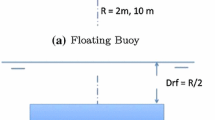Abstract
Understanding the motions of offshore structures, which are continuously affected by waves, is important. Thus, experimental approaches have traditionally been favored. However, computational methods are currently preferred because they reflect dynamic behavior more efficiently than experiments. The incompressible smoothed particle hydrodynamics was used in this study to model the waves and interactions with a buoy. Validation data for wave-structure interactions were obtained by using a wave tank. An incident sinusoidal wave was generated by a piston-type wave-maker, while a non-moored cylindrical buoy moved freely horizontally and vertically. Vertical motions must be predicted because the vertical motions of offshore structures considerably affect system performance. An IWD-IMU V1 sensor was used to measure buoy motion, and the vertical acceleration was compared with simulation data. The wave-structure interaction method considers the buoyancy force by the reference to the mass difference between a solid and a hollow buoy. Wave periods of 1.42, 1.58, 2.0, and 2.24 s were used. Buoy vertical acceleration was in increasingly good agreement with the experimental results as the wave period increased. This finding confirms that the proposed method predicts vertical buoy motion.
Similar content being viewed by others
References
R. A. Gingold and J. J. Monaghan, Smoothed particle hydrodynamics theory and application to non-spherical stars, Mon. Not. R. Astron. Soc., 181 (1977) 375–89.
L. B. Lucy, A numerical approach to the testing of the fission hypothesis, Astronomical Journal, 82 (1977) 1013–1024.
S. J. Cummins and M. Rudman, An SPH projection method, Journal of Computational Physics, 152 (2) (1999) 584–607.
E. S. Lee, Truly incompressible approach for computing incompressible flow in SPH and comparisons with the traditional weakly compressible approach, Ph.D. Thesis, The University of Manchester (2007).
A. D. Chow, B. D. Rogers, S. J. Lind and P. K. Stansby, Incompressible SPH(ISPH) with fast Poisson solver on a GPU, Computer Physics Communications, 226 (2018) 81–103.
T. Takahashi, U. Heihachi and A. Kunimatsu, The simulation of fluid-rigid body interaction, The 29th International Conference on Computer Graphics and Interactive Techniques (2002).
T. Takahashi, H. Fujii, A. Kunimtsu, K. Hiwaka, T. Saito, K. Tanaka and H. Ueki, Realistic animation of fluid with splash and foam, Computer Graphics Forum, 22 (3) (2003) 391–401.
S. Oh, Y. Kim and B.-S. Roh, Impulsed-based rigid body interaction in SPH, Comp. Anim. Virtual Worlds, 20 (2009) 215–224.
J. J. Monaghan, Smoothed particle hydrodynamics, Rep. Prog. Phys., 68 (2005) 1703–1759.
N. Akinci, M. Ihmsen, G. Akinici, B. Solenthaler and M. Teschner, Versatile rigid-fluid coupling for incompressible SPH, ACM TOG, Proc. of SIGGRAPH 2012 (2012).
D. F. Gunn, M. Rudman and R. C. Z. Cohen, Wave interaction with a tethered buoy: SPH simulation and experimental validation, Ocean Engineering, 156 (2018) 306–317.
S. Koshizuka, N. Atsushi and O. Yoshiaki, Numerical analysis of breaking waves using the moving particle semiimplicit method, International Journal for Numerical Methods in Fluids, 26 (7) (1998) 751–769.
T. Sarpkaya, Wave Forces on Offshore Structures, Cambridge University Press (2010).
C. W. Jun, J. H. Shin and J. H. Sohn, Comparison of the pendulum motion of a buoy subjected to wave load with experiments, Journal of Mechanical Science and Technology, 33 (7) (2019).
J. Bonet and T. S. L. Lok, Variational and momentum preservation aspects of Smooth Particle Hydrodynamic formulations, Comput. Methods Appl. Mech. Engrg., 180 (1999) 97–115.
J. Sanders and E. Kandrot, CUDA by Example: An Introduction to General-purpose GPU Programming, Addison- Wesley Professional (2010).
NVIDIA, CUDA C Programming Guide v7.5, NVIDA Corporation (2015).
H. J. Ryu, K. Y. Hong, S. H. Shin, M. S. Song and D. Y. Kim, Analysis of long-term wave distribution at Jeju sea based on SWAN model simulation, Journal of the Korean Society for Marine Environmental Engineering, 7 (3) (2004) 137–145.
R. Xu, An improved incompressible smoothed particle hydrodynamics method and its application in free-surface simulation, Ph.D. Thesis, The University of Manchester (2009).
A. Pecher and J. P. Kofoed, Handbook of Ocean Wave Energy, Ocean Engineering & Oceanography, 7 (2017).
Acknowledgments
This research was a part of the project titled “Development of fluid-multibody coupled analysis techniques for improving the performance of wave power generating system,” which was funded by the Ministry of Oceans and Fisheries, Korea.
Author information
Authors and Affiliations
Corresponding author
Additional information
Recommended by Editor No-cheol Park
Chul Woong Jun is a Ph.D. of the Department of Mechanical Design Engineering at Pukyong National University, Busan, Korea. His interests include parallel computing, particle dynamics, and multibody system dynamics.
Jeong Hoon Shin is a graduate student of Mechanical Engineering at Pukyong National University, Busan, Korea. His research interests include vehicle dynamics and dynamic analysis of multibody systems.
Jeong Hyun Sohn is a Professor at the Department of Mechanical Design Engineering at Pukyong National University, Busan, Korea. His research interests include mechanism design and multibody system dynamics.
Rights and permissions
About this article
Cite this article
Jun, CW., Shin, JH. & Sohn, JH. Incompressible SPH simulation and experimental validation of Buoy-Wave interaction. J Mech Sci Technol 34, 1475–1483 (2020). https://doi.org/10.1007/s12206-020-0309-y
Received:
Revised:
Accepted:
Published:
Issue Date:
DOI: https://doi.org/10.1007/s12206-020-0309-y



